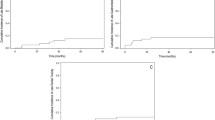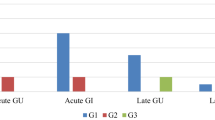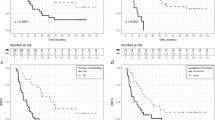Abstract
Purpose
To analyze clinical results and quality of life of patients with localized prostate cancer after irradiation of the prostate with an 18F-choline-PET/CT-based simultaneous integrated boost (SIB) in comparison to a control group without SIB.
Methods
A total of 134 patients underwent intensity-modulated radiotherapy from 2007–2010. All patients received a total dose of 76 Gy with 2 Gy fractions to the prostate; 67 patients received an additional SIB of 80 Gy. The median follow-up was 65 months. Quality of life was evaluated with the EPIC (Expanded Prostate Cancer Index Composite) questionnaire.
Results
Baseline characteristics were similar in both groups (prostate-specific antigen 11 ng/ml vs. 8 ng/ml, p = 0.20, Gleason score <6 in 36% vs. 46%, p = 0.22, with vs. without SIB). No prostate cancer-related death was observed. No significant difference of quality of life scores was found. The largest difference after 5–6 years in comparison to baseline was reported for sexual bother (mean 15 vs. 17 points with vs. without SIB). Mean urinary scores did not decrease. Bowel bother scores changes were larger in the SIB group (mean 5 vs. 2 points, dependent on SIB volume), with increased bowel problems (15 vs. 2% big/moderate problem with bowel movements, p = 0.03). However, a trend towards higher efficacy with SIB resulted (biochemical recurrence-free survival of 92% vs. 85%, p = 0.17).
Conclusions
The first long-term analysis of patients treated with SIB based on molecular imaging with 18-F-choline-PET/CT showed an excellent biochemical recurrence-free survival, but a larger percentage of bowel problems in comparison to the control group.
Zusammenfassung
Zielsetzung
Untersuchung der klinischen Ergebnisse und der Lebensqualität von Patienten mit lokal begrenztem Prostatakarzinom nach Bestrahlung mit simultan integriertem Boost (SIB) nach molekularer Bildgebung mit 18F-Cholin-PET/CT im Vergleich zu einer Kontrollgruppe ohne Boost.
Methoden
In den Jahren 2007–2010 erhielten 134 Patienten eine intensitätsmodulierte Radiotherapie beim Prostatakarzinom: alle Patienten mit einer Gesamtdosis von 76 Gy in 2‑Gy-Einzeldosen und 67 mit einem zusätzlichen SIB bis 80 Gy. Die mediane Nachbeobachtungszeit betrug 65 Monate. Die Lebensqualität wurde mit dem EPIC-Fragebogen (Expanded Prostata Cancer Index Composite) evaluiert.
Ergebnisse
Basisdaten der Patienten waren in beiden Gruppen ähnlich (prostataspezifsches Antigen im Mittel 11 ng/ml vs. 8 ng/ml, p = 0,20; Gleason-Score <6 in 36 % vs. 46 %, p = 0,22, mit vs. ohne SIB). Kein Patient verstarb am Prostatakarzinom. Die Veränderungen der Lebensqualitätsscores waren nicht signifikant unterschiedlich. Die größte Veränderung zwischen Beginn und nach 5–6 Jahren zeigte sich bei sexuellen Problemen (durchschnittlich 15 vs. 17 Punkte mit vs. ohne SIB). Der Miktionsscore verschlechterte sich im Mittel nicht. Belastungsscores für den Stuhlgang waren mit SIB größer (durchschnittlich 5 vs. 2 Punkte, abhängig vom SIB-Volumen), mit vermehrten abdominellen Beschwerden (15 vs. 2 % starke/moderate Beschwerden mit dem Stuhlgang; p = 0,03). Es zeigte sich jedoch ein Trend für eine bessere Tumorkontrolle mit SIB (biochemisch rezidivfreies Überleben von 92 % vs. 85 %; p = 0,17).
Schlussfolgerung
Die erste klinische Langzeitnachbeobachtung von Patienten, die mit SIB nach molekularer Bildgebung mit 18F-Cholin-PET/CT bestrahlt wurden, ergab eine hervorragende biochemische Kontrolle, jedoch mit vermehrter Häufigkeit abdomineller Beschwerden als in der Kontrollgruppe.


Similar content being viewed by others
References
Maggio A, Panaia R, Garibaldi E, Bresciani S, Malinverni G, Stasi M, Gabriele P (2012) Impact of age at diagnosis on overall and disease-free survival in men with prostate cancer following conformal 3D radiation therapy. Tumori 98:722–727
Narayan VM, Konety BR, Warlick C (2017) Novel biomarkers for prostate cancer: an evidence-based review for use in clinical practice. Int J Urol 24(5):352–360. https://doi.org/10.1111/iju.13326
Fedorov A, Vangel MG, Tempany CM, Fennessy FM (2017) Multiparametric magnetic resonance imaging of the prostate: repeatability of volume and apparent diffusion coefficient quantification. Invest Radiol 52(9):538–546. https://doi.org/10.1097/RLI.0000000000000382
Di Franco CA, Jallous H, Porru D, Giliberto GL, Cebrelli T, Tinelli C, Rovereto B (2017) A retrospective comparison between transrectal and transperineal prostate biopsy in the detection of prostate cancer. Arch Ital Urol Androl 89:55–59
Ganzer R (2017) High intensity focused ultrasound (HIFU): importance in the treatment of prostate cancer. Radiologe 57(8):659–664. https://doi.org/10.1007/s00117-017-0245-8
Tyloch JF, Wieczorek AP (2017) The standards of an ultrasound examination of the prostate gland. Part 2. J Ultrason 17:43–58
Pinkawa M, Eble MJ, Mottaghy FM (2011) PET and PET/CT in radiation treatment planning for prostate cancer. Expert Rev Anticancer Ther 11:1033–1039
De MG, Villeirs G, Bral S, Paelinck L, De GW, Dekuyper P, De NW (2005) The magnetic resonance detected intraprostatic lesion in prostate cancer: planning and delivery of intensity-modulated radiotherapy. Radiother Oncol 75:325–333
Grossmann M, Wittert G (2012) Androgens, diabetes and prostate cancer. Endocr Relat Cancer 19:F47–F62
Gudmundsson J, Sulem P, Steinthorsdottir V, Bergthorsson JT, Thorleifsson G, Manolescu A, Rafnar T, Gudbjartsson D, Agnarsson BA, Baker A, Sigurdsson A, Benediktsdottir KR, Jakobsdottir M, Blondal T, Stacey SN, Helgason A, Gunnarsdottir S, Olafsdottir A, Kristinsson KT, Birgisdottir B, Ghosh S, Thorlacius S, Magnusdottir D, Stefansdottir G, Kristjansson K, Bagger Y, Wilensky RL, Reilly MP, Morris AD, Kimber CH, Adeyemo A, Chen Y, Zhou J, So WY, Tong PC, Ng MC, Hansen T, Andersen G, Borch-Johnsen K, Jorgensen T, Tres A, Fuertes F, Ruiz-Echarri M, Asin L, Saez B, van Boven E, Klaver S, Swinkels DW, Aben KK, Graif T, Cashy J, Suarez BK, van Vierssen TO, Frigge ML, Ober C, Hofker MH, Wijmenga C, Christiansen C, Rader DJ, Palmer CN, Rotimi C, Chan JC, Pedersen O, Sigurdsson G, Benediktsson R, Jonsson E, Einarsson GV, Mayordomo JI, Catalona WJ, Kiemeney LA, Barkardottir RB, Gulcher JR, Thorsteinsdottir U, Kong A, Stefansson K (2007) Two variants on chromosome 17 confer prostate cancer risk, and the one in TCF2 protects against type 2 diabetes. Nat Genet 39:977–983
O’Brien JM (2000) Environmental and heritable factors in the causation of cancer: analyses of cohorts of twins from Sweden, Denmark, and Finland, by P. Lichtenstein, N.V. Holm, P.K. Verkasalo, A. Iliadou, J. Kaprio, M. Koskenvuo, E. Pukkala, A. Skytthe, and K. Hemminki. N Engl J Med 343:78–84, 2000. Surv Ophthalmol 45:167–168
Rodriguez C, Patel AV, Mondul AM, Jacobs EJ, Thun MJ, Calle EE (2005) Diabetes and risk of prostate cancer in a prospective cohort of US men. Am J Epidemiol 161:147–152
de Carvalho TM, Heijnsdijk EAM, de Koning HJ (2017) When should active surveillance for prostate cancer stop if no progression is detected? Prostate 77:962–969
Lips IM, van der Heide UA, Haustermans K, van Lin EN, Pos F, Franken SP, Kotte AN, van Gils CH, van Vulpen M (2011) Single blind randomized phase III trial to investigate the benefit of a focal lesion ablative microboost in prostate cancer (FLAME-trial): study protocol for a randomized controlled trial. Trials 12:255
Semerjian A, Pavlovich CP (2017) Extraperitoneal robot-assisted radical prostatectomy: indications, technique and outcomes. Curr Urol Rep 18:42
Panje CM, Dal PA, Zilli T, Zwahlen R, Papachristofilou A, Herrera FG, Matzinger O, Plasswilm L, Putora PM (2015) Consensus and differences in primary radiotherapy for localized and locally advanced prostate cancer in Switzerland: a survey on patterns of practice. Strahlenther Onkol 191:778–786
Hocht S, Aebersold DM, Albrecht C, Bohmer D, Flentje M, Ganswindt U, Holscher T, Martin T, Sedlmayer F, Wenz F, Zips D, Wiegel T (2017) Hypofractionated radiotherapy for localized prostate cancer. Strahlenther Onkol 193:1–12
Fonteyne V, Villeirs G, Speleers B, De NW, De WC, Lumen N, De MG (2008) Intensity-modulated radiotherapy as primary therapy for prostate cancer: report on acute toxicity after dose escalation with simultaneous integrated boost to intraprostatic lesion. Int J Radiat Oncol Biol Phys 72:799–807
Pinkawa M, Holy R, Piroth MD, Fischedick K, Schaar S, Szekely-Orban D, Eble MJ (2010) Consequential late effects after radiotherapy for prostate cancer—a prospective longitudinal quality of life study. Radiat Oncol 5:27
Pinkawa M, Berneking V, Konig L, Frank D, Bretgeld M, Eble MJ (2017) Hydrogel injection reduces rectal toxicity after radiotherapy for localized prostate cancer. Strahlenther Onkol 193:22–28
Viani GA, Stefano EJ, Afonso SL (2009) Higher-than-conventional radiation doses in localized prostate cancer treatment: a meta-analysis of randomized, controlled trials. Int J Radiat Oncol Biol Phys 74:1405–1418
Pinkawa M, Attieh C, Piroth MD, Holy R, Nussen S, Klotz J, Hawickhorst R, Schafer W, Eble MJ (2009) Dose-escalation using intensity-modulated radiotherapy for prostate cancer—evaluation of the dose distribution with and without 18F-choline PET-CT detected simultaneous integrated boost. Radiother Oncol 93:213–219
Pinkawa M, Holy R, Piroth MD, Klotz J, Nussen S, Krohn T, Mottaghy FM, Weibrecht M, Eble MJ (2010) Intensity-modulated radiotherapy for prostate cancer implementing molecular imaging with 18F-choline PET-CT to define a simultaneous integrated boost. Strahlenther Onkol 186:600–606
Kwee SA, Wei H, Sesterhenn I, Yun D, Coel MN (2006) Localization of primary prostate cancer with dual-phase 18F-fluorocholine PET. J Nucl Med 47:262–269
Pinkawa M, Pursch-Lee M, Asadpour B, Gagel B, Piroth MD, Klotz J, Nussen S, Eble MJ (2008) Image-guided radiotherapy for prostate cancer. Strahlenther Onkol 184:679–685
Wei JT, Dunn RL, Litwin MS, Sandler HM, Sanda MG (2000) Development and validation of the expanded prostate cancer index composite (EPIC) for comprehensive assessment of health-related quality of life in men with prostate cancer. Urology 56:899–905
Osoba D, Rodrigues G, Myles J, Zee B, Pater J (1998) Interpreting the significance of changes in health-related quality-of-life scores. J Clin Oncol 16:139–144
Pinkawa M, Holy R, Piroth DM, Klotz J, Pfister D, Heidenreich A, Eble MJ (2011) Interpreting the clinical significance of quality of life score changes after radiotherapy for localized prostate cancer. Curr Urol Rep 5:137–144
Volz-Sidiropoulou E, Pinkawa M, Fischedick K, Jakse G, Gauggel S, Eble MJ (2009) Factor analysis of the Expanded Prostate Cancer Index Composite (EPIC) in a patient group after primary (external beam radiotherapy and permanent iodine-125 brachytherapy) an postoperative radiotherapy for prostate cancer. Curr Urol Rep 2:122–129
Rinnab L, Blumstein NM, Mottaghy FM, Hautmann RE, Kufer R, Hohl K, Reske SN (2007) 11C-choline positron-emission tomography/computed tomography and transrectal ultrasonography for staging localized prostate cancer. BJU Int 99:1421–1426
Brenner DJ (2008) The linear-quadratic model is an appropriate methodology for determining isoeffective doses at large doses per fraction. Semin Radiat Oncol 18:234–239
Pinkawa M, Piroth MD, Holy R, Klotz J, Djukic V, Escobar-Corral N, Caffaro M, Winz OH, Krohn T, Mottaghy FM, Eble MJ (2012) Dose-escalation using intensity-modulated radiotherapy for prostate cancer—evaluation of quality of life with and without 18F-choline PET-CT detected simultaneous integrated boost. Radiat Oncol 7:14
Sundahl N, De MG, Villeirs G, Ost P, De NW, Lumen N, De VP, Van EM, Fonteyne V (2016) Combining high dose external beam radiotherapy with a simultaneous integrated boost to the dominant intraprostatic lesion: analysis of genito-urinary and rectal toxicity. Radiother Oncol 119:398–404
Zielinski A, Behrendt FF, Verburg FA, Mottaghy FM, Krohn T (2014) Phantom studies and clinical application of high resolution, image reconstruction using (18)F-fluoromethylcholine PET/CT for prostate cancer. Hell J Nucl Med 17:194–199
Wetter A, Nensa F, Schenck M, Heusch P, Poppel T, Bockisch A, Forsting M, Schlosser TW, Lauenstein TC, Nagarajah J (2014) Combined PET imaging and diffusion-weighted imaging of intermediate and high-risk primary prostate carcinomas with simultaneous [18F] choline PET/MRI. PLoS ONE 9:e101571
Turkbey B, Pinto PA, Choyke PL (2009) Imaging techniques for prostate cancer: implications for focal therapy. Nat Rev Urol 6:191–203
Van den Bergh L, Koole M, Isebaert S, Joniau S, Deroose CM, Oyen R, Lerut E, Budiharto T, Mottaghy F, Bormans G, Van PH, Haustermans K (2012) Is there an additional value of (1)(1)C-choline PET-CT to T2-weighted MRI images in the localization of intraprostatic tumor nodules? Int J Radiat Oncol Biol Phys 83:1486–1492
Zamboglou C, Wieser G, Hennies S, Rempel I, Kirste S, Soschynski M, Rischke HC, Fechter T, Jilg CA, Langer M, Meyer PT, Bock M, Grosu AL (2016) MRI versus (68)Ga-PSMA PET/CT for gross tumour volume delineation in radiation treatment planning of primary prostate cancer. Eur J Nucl Med Mol Imaging 43:889–897
Eiber M, Weirich G, Holzapfel K, Souvatzoglou M, Haller B, Rauscher I, Beer AJ, Wester HJ, Gschwend J, Schwaiger M, Maurer T (2016) Simultaneous 68 Ga-PSMA HBED-CC PET/MRI improves the localization of primary prostate cancer. Eur Urol 70:829–836
Bluemel C, Krebs M, Polat B, Linke F, Eiber M, Samnick S, Lapa C, Lassmann M, Riedmiller H, Czernin J, Rubello D, Bley T, Kropf S, Wester HJ, Buck AK, Herrmann K (2016) 68 Ga-PSMA-PET/CT in patients with biochemical prostate cancer recurrence and negative 18F-choline-PET/CT. Clin Nucl Med 41:515–521
Author information
Authors and Affiliations
Corresponding author
Ethics declarations
Conflict of interest
M. Schlenter, V. Berneking, B. Krenkel, F.M. Mottaghy, T.-A. Vögeli, M.J. Eble and M. Pinkawa declare that they have no competing interests.
Rights and permissions
About this article
Cite this article
Schlenter, M., Berneking, V., Krenkel, B. et al. Intensity-modulated radiotherapy of prostate cancer with simultaneous integrated boost after molecular imaging with 18F-choline-PET/CT. Strahlenther Onkol 194, 638–645 (2018). https://doi.org/10.1007/s00066-018-1282-6
Received:
Accepted:
Published:
Issue Date:
DOI: https://doi.org/10.1007/s00066-018-1282-6
Keywords
- Prostate cancer
- Intensity-modulated radiotherapy
- 18F-choline-PET/CT
- Quality of life
- Image-guided radiotherapy




